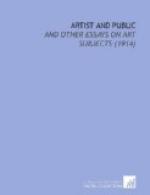We know comparatively little of the painting of antiquity, but we have no reason to suppose that that art, however admirable, ever attained to ripeness, and we know that the painting of the Orient has stopped short at a comparatively early stage of development. For our purpose the art to be studied is the painting of modern times in Europe from its origin in the Middle Ages. Even in the beginning, or before the beginning, while painting is a decadent reminiscence of the past rather than a prophecy of the new birth, there are decorative splendors in the Byzantine mosaics hardly to be recaptured. Then comes primitive painting, an art of the line and of pure color with little modulation and no attempt at the rendering of solid form. It gradually attains to some sense of relief by the use of degrees of light and less light; but the instant it admits the true shadow the old brightness and purity of color have become impossible. The line remains dominant for a time and is carried to the pitch of refinement and beauty, but the love for solid form gradually overcomes it, and in the art of the high Renaissance it takes a second place. Then light-and-shade begins to be studied for its own sake; color, no longer pure and bright, but deep and resonant, comes in again; the line vanishes altogether, and even form becomes secondary. The last step is taken by Rembrandt, and even color is subordinated to light-and-shade, which exists alone in a world of brownness. At every step there has been progress, but there has also been regress. Perhaps the greatest balance of gain against loss and the nearest approach to a complete art of painting were with the great Venetians. The transformation is still going on, and in our own day we have conquered some corners of the science of visible aspects which were unexplored by our ancestors. But the balance has turned against us; our loss has been greater than our gain; and our art, even in its scientific aspect, is inferior to that of the sixteenth and seventeenth centuries.
And just because there never has been a complete art of painting, entirely rounded and perfected, it is the clearer to us that the final value of a work in that art never has depended on its approach to such completion. There is no one supreme master of painting but a long succession of masters of different yet equal glory. If the masterpieces of architecture are everywhere because there has often been a complete art of architecture, the masterpieces of painting are everywhere for the opposite reason. And if we do not always value a master the more as his art is more nearly complete, neither do we always value him especially who has placed new scientific conquests at the disposal of art. Palma Vecchio painted by the side of Titian, but he is only a minor master; Botticelli remained of the generation before Leonardo, but he is one of the immortal great. Paolo Ucello, by his study of perspective, made a distinct advance in pictorial science, but his interest for us is purely historic; Fra Angelico made no advance whatever, but he practised consummately the current art as he found it, and his work is eternally delightful. At every stage of its development the art of painting has been a sufficient medium for the expression of a great man’s mind; and wherever and whenever a great man has practised it, the result has been a great and permanently valuable work of art.




